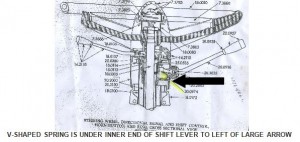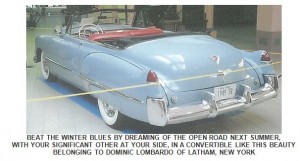Does your shift lever loosely flop from front to back rather than spring toward the front of the car when you remove your hand from it? Maybe your lever is “sloppy” from side to side, too. If so, and your ’49 is not one of the 11 belonging to chapter members with stick shift (as the s lever is different), read on.
As shown in the drawing below of a similar 1955 Cadillac steering column, the back-to-front position of the Hydra-matic shift lever is controlled by a flat V-shaped spring inside the steering column just under the inner end of the shift lever.
Occasionally, these springs simply snap in two, allowing the lever to merely flop. While you can still shift between N, Dr. Lo and R, it can be very annoying to the driver as it just won’t feel quite right. I recently helped Art Gardner and Frank Lindauer, Times Editor and Editor Emeritus, respectively, install new springs in their steering columns and feel it would be useful to summarize how it was done.
1. Get a new spring. Occasionally, they are offered for sale on Ebay, where Frank got his for $15 or so. Another source is CLC member Joe Alcorn, 111 W. Park Blvd., Westmont NJ 08108-3345, phone:
856-858-8899, who apparently has a stock of them.
2. Disconnect a battery cable so the unwanted sound of your horn doesn’t drive you and anyone else to distraction. Next, remove the horn button by holding the horn ring toward you with one hand, while simultaneously pressing in and turning the button counter-clockwise about 1/3 of a turn to release it. Note that the big end of the cone-shaped spring under the button is toward you. Remove the spring.
3. Remove the large nut that fastens the steering wheel and horn ring to the steering column. Lift off the horn ring assembly. Make two small adjacent witness marks with a punch on the splined steering wheel hub and the steering column shaft so that you replace the steering wheel in the same position when the job is done. Using a steering wheel puller, remove the steering wheel.
4. You have now exposed the innards of the directional signal housing. Looking into it, you will see four Phillips screws that hold the housing to the steering column. As these screws are recessed behind part of the housing and can’t be reached with your fingers, it is best to remove them with a magnetic screw driver. If you don’t have one, you may drop the screws inside the housing after unscrewing them, so keep handy a mechanic’s magnet and a pair of small tweezers to retrieve them.
5. Once the screws are removed, you must pull the doughnut-shaped directional signal housing and the cable attached to it toward you and around the top of the steering column shaft to expose the shift lever housing underneath. You may find that the directional signal cable is too short to allow the housing to be pulled sufficiently toward you and you can’t get it around the top of the steering column shaft. If so, don’t lose your cool, but reach down under the dashboard to the point on the steering column where the directional signal cables enter the column and carefully push them further into the steering column. After playing around with the cables a bit under the dash you should free them up enough at their upper end to be able pull the housing around the top of the steering column shaft and set it to one side.
6. Now, you must remove the shift lever. First, unscrew the chrome cup at the inner end of the lever from the steering column. In doing so you will expose a tapered hinge pin upon which the lever pivots. Using a small punch or Phillips screwdriver, gently tap the pin up from bottom to top (it can only go one way). Remove the pin and pull out the lever. As you remove the lever, note and collect the little anti-rattle springs that flank the lever, if they are present.
7. You should now be able to see the broken parts of the V-shaped spring that you will replace. Pull these out with tweezers. The new spring must be installed with the two V arms facing toward the inside of the steering column. (See diagram above.) You may have to manipulate it a bit and even tap it in with a small punch and hammer. Now, lightly grease the spring, the shift lever and hinge pin, then re-install the lever over the top leaf of the spring. Re-install everything else in reverse order and you are done.
NOTE: the large nut that fastens the steering wheel and horn ring to the steering column must be torqued to 45-50 foot-pounds. Hold the torque wrench in one hand and the rim of the steering wheel with the other.

